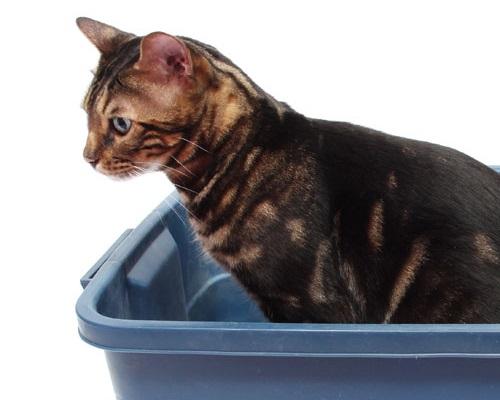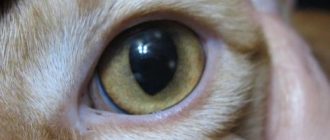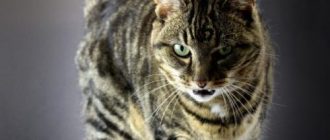The word constipation, or constipation, is used to describe problems with the passage of feces or stool, difficulties encountered with bowel movements, with rare stools or complete obstruction intestines, which leads to the cat’s state when she’s not can go to the toilet at all.

When a cat has constipation, it means that the feces that did not come out naturally, remained in the intestines and in the thick gut, which in turn leads to their compaction, hardening and may make the problem worse. This condition is also known as constipation, or severe constipation, when a cat’s colon expands and can no longer independently push feces from a direct guts. This state of expansion and lengthening of the colon called the megacolon.
Constipation, for obvious reasons, causes severe discomfort and can to be very painful. It is important to understand the initial symptoms of constipation in cats to be able to apply for as soon as possible help.
What are the causes of constipation in cats?
Contents
There are many possible causes of constipation in cats, and they can have both behavioral and medical character. If the cat is stressed when going to the toilet because she doesn’t have a safe place, or her tray is too dirty, or she’s not in able to go outside, when I’m used to it, it can lead to unwillingness to go to the toilet at all. Of course it is uncomfortable and unpleasant for your cat, because all cats in their own way nature is very clean creatures, and often go to great lengths to to avoid confusion and not go to places that they don’t like.
Along with the psychological reasons for not wanting to go to the toilet, any of the following common problems can also lead to cat constipation:
- Pain or inflammation in the limbs, tail, or back, which may cause discomfort in a squatting position.
- Injuries, abscesses, or infections in the colon that cause pain or discomfort while passing stool.
- Bladder inflammation or infection, which may also cause pain during bowel movements.
- Dehydration can lead to cat stool will be too dry and harsh. It may be caused by another a cause that in itself can lead to constipation, for example, kidney problems.
- Obstruction in the colon itself that may be caused pelvic injury or anatomical problems.
- Foreign bodies in the stool, such as lumps of wool or bone.
- Insufficient diet fiber.
- Problems with the anal glands.
- Roughly tangled hair around the anus, especially in long-haired cats.
- Some neurological diseases that can lead to problems in the spinal cord.
- Digestive or endocrine diseases such as cancer and some others.
Symptoms of constipation in cats
Cat constipation can be difficult to determine if your cat usually goes to the toilet outside, leaving you less aware of your pet’s normal procedures. Be be careful and watch for the following signs that something is goes wrong when a cat goes to the toilet:
- A small stool that can be dry and hard.
- Stress and obvious difficulties during bowel movements.
- Signs of pain, such as whining, while passing stool.
- Stool that is covered with mucus or blood, or contains visible traces of blood.
- Frequent visits to a tray or other place for a toilet without result.
- Weakness and disinterest in care.
- Loss of appetite and weight.
- Vomiting or nausea.
- Lethargy and a general lack of interest in anything.
- A heavy, distended abdomen and any signs of soreness with touching the abdomen.
Diagnosis and treatment of constipation in cats
In addition to directly treating constipation, it is important to determine the root the cause of the problem. The vet is likely to perform physical examination of the cat, and may also use additional tests, such as a colonoscopy or radiograph in case of severe constipation.
To identify and eliminate the cause of constipation, which may be behavioral, medical or neurological, the veterinarian may take one or more of the following procedures to resolve immediate constipation problem:
- The introduction of stool softeners, which will make natural bowel movements easier.
- Infusion therapy to help eliminate dehydration.
- The introduction of an enema to soften and break the stool.
- Manual rectal cleansing.
- Foreign body removal operation or troubleshooting anatomy that cause obstruction.
- Prescribing a special diet or supplements that contain large amounts of fiber to prevent relapse.
What types of cats suffer most from constipation?
Theoretically, any cat can develop at some point constipation, as there are many possible causes for this condition.
Older cats are more prone to constipation than younger cats, just like any cat whose diet is low in fiber is at high risk. However, some breeds cats are more likely to develop chronic or recurrent constipation than others. These include, for example, the male cat, which lacks a tail, sometimes accompanied by others anatomical problems of the spine, which can lead to various problems with the intestines and colon.






